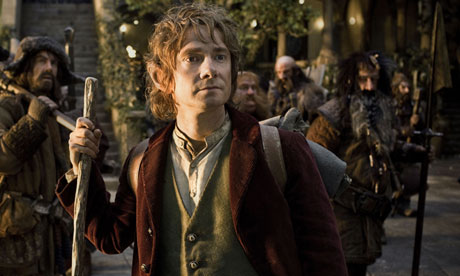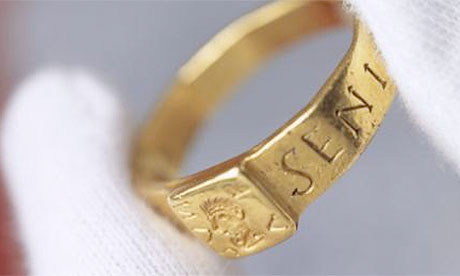The Hobbit ring that may have inspired Tolkien put on show
Lord of the Rings author was researching the story of the curse of a Roman ring for two years before starting Bilbo Baggins tale

The Hobbit may have
been the result of JRR Tolkien's fascination with the a real-life cursed
ring story. Photograph: New Line Cinema/Sportsphoto Ltd./Allstar
In what was once the housekeeper's office of a Tudor mansion in
Hampshire, a very odd golden ring glitters on a revolving stand in a
tall perspex column. In chapter five of The Hobbit, Bilbo Baggins finds a
ring in the gloom of Gollum's cave. Not just any ring. "One very
beautiful thing, very beautiful, very wonderful. He had a ring, a golden
ring, a precious ring."
A new exhibition opening today at The Vyne, now owned by the National Trust, raises the intriguing possibility that the Roman ring in the case, and the ring of power in JRR Tolkien's book The Hobbit, and in his Lord of the Rings trilogy, are one and the same.
As Dave Green, the property manager, explains, there's more to the story than the ring – an iron-age site with ancient mine workings known as "the Dwarf's Hill", a curse on the thief who stole the ring, and a strong link to Tolkien himself.
Tolkien was a professor of Anglo-Saxon at Oxford before he found fame as an author, with the publication of The Hobbit in 1937, and the first of the Rings trilogy in 1954. He certainly knew the story of the curse and the ring, and was researching the subject two years before he began work on The Hobbit.
The ring was in the collection of the Chute family – which for generations was interested in politics, collecting, and antiquarian research – for centuries before the house came to the National Trust in the 1930s.
"I was looking for the ring to show a visitor, and I walked right past the case with it – that's when I decided we really had to make more of this amazing thing," Green said. As well as the exhibition room, created with the help of the Tolkien Trust, the house now has a dwarf trail for children and a new playground with circular tunnels and green hillocks recalling Bilbo's home, Bag End.
The ring was probably found in 1785 by a farmer ploughing a few miles away within the walls of Silchester, one of the most enigmatic Roman sites in the country – a town which flourished before the Roman invasion, was abandoned by the 7th century and was never reoccupied.
There are no details of exactly when it was found, but historians assume the farmer sold it to the history loving wealthy family at The Vyne. It was a strikingly odd object, 12g of gold so large that it would only fit on a gloved thumb, ornamented with a peculiar spiky head wearing a diadem, and a Latin inscription reading: "Senicianus live well in God".
 The 'cursed' Roman ring that may have inspired Tolkien's Hobbit books. Photograph: National Trust
A few decades later and 100 miles away, more of the story turned up:
at Lydney in Gloucestershire, a Roman site known locally as the Dwarf's
Hill, a tablet with an inscribed curse was found. A Roman called
Silvianus informs the god Nodens that his ring has been stolen. He knows
the villain responsible, and he wants the god to sort them out: "Among
those who bear the name of Senicianus to none grant health until he
bring back the ring to the temple of Nodens."
The 'cursed' Roman ring that may have inspired Tolkien's Hobbit books. Photograph: National Trust
A few decades later and 100 miles away, more of the story turned up:
at Lydney in Gloucestershire, a Roman site known locally as the Dwarf's
Hill, a tablet with an inscribed curse was found. A Roman called
Silvianus informs the god Nodens that his ring has been stolen. He knows
the villain responsible, and he wants the god to sort them out: "Among
those who bear the name of Senicianus to none grant health until he
bring back the ring to the temple of Nodens."
Lydney was re-excavated by the maverick archaeologist Sir Mortimer Wheeler, who called in Tolkien in 1929 to advise on the odd name of the god – and also spotted the connection between the name on the curse and the Chute family's peculiar ring. It seems that Senicianus only got as far as Silchester before he lost his booty.
Dr Lynn Forest-Hill of the Tolkien Society said Tolkien's source was usually assumed to be literary sources, including the Niebelung legends. "It is, then, particularly fascinating to see the physical evidence of the Vyne ring, with its links to Tolkien through the inscription associating it with a curse."
The ring is now on display with a first edition of The Hobbit and a copy of the curse – visitors are invited to vote on whether they are looking at the original of Bilbo's ring.
• This article was amended on 4 April 2013. In the original, Dr Lynn Forest-Hill was said to be "of the Tolkien Trust". She is in fact the education officer of the Tolkien Society and is not connected to the Tolkien Trust.
- The Hobbit: An Unexpected Journey
- Production year: 2011
- Country: Rest of the world
- Cert (UK): 12A
- Runtime: 169 mins
- Directors: Peter Jackson
- Cast: Aidan Turner, Andy Serkis, Benedict Cumberbatch, Billy Connolly, Cate Blanchett, Christopher Lee, Elijah Wood, Evangeline Lilly, Hugo Weaving, Ian Holm, Ian McKellen, Lee Pace, Luke Evans, Martin Freeman, Orlando Bloom, Richard Armitage, Sir Ian McKellen, Stephen Fry
As Dave Green, the property manager, explains, there's more to the story than the ring – an iron-age site with ancient mine workings known as "the Dwarf's Hill", a curse on the thief who stole the ring, and a strong link to Tolkien himself.
Tolkien was a professor of Anglo-Saxon at Oxford before he found fame as an author, with the publication of The Hobbit in 1937, and the first of the Rings trilogy in 1954. He certainly knew the story of the curse and the ring, and was researching the subject two years before he began work on The Hobbit.
The ring was in the collection of the Chute family – which for generations was interested in politics, collecting, and antiquarian research – for centuries before the house came to the National Trust in the 1930s.
"I was looking for the ring to show a visitor, and I walked right past the case with it – that's when I decided we really had to make more of this amazing thing," Green said. As well as the exhibition room, created with the help of the Tolkien Trust, the house now has a dwarf trail for children and a new playground with circular tunnels and green hillocks recalling Bilbo's home, Bag End.
The ring was probably found in 1785 by a farmer ploughing a few miles away within the walls of Silchester, one of the most enigmatic Roman sites in the country – a town which flourished before the Roman invasion, was abandoned by the 7th century and was never reoccupied.
There are no details of exactly when it was found, but historians assume the farmer sold it to the history loving wealthy family at The Vyne. It was a strikingly odd object, 12g of gold so large that it would only fit on a gloved thumb, ornamented with a peculiar spiky head wearing a diadem, and a Latin inscription reading: "Senicianus live well in God".
 The 'cursed' Roman ring that may have inspired Tolkien's Hobbit books. Photograph: National Trust
A few decades later and 100 miles away, more of the story turned up:
at Lydney in Gloucestershire, a Roman site known locally as the Dwarf's
Hill, a tablet with an inscribed curse was found. A Roman called
Silvianus informs the god Nodens that his ring has been stolen. He knows
the villain responsible, and he wants the god to sort them out: "Among
those who bear the name of Senicianus to none grant health until he
bring back the ring to the temple of Nodens."
The 'cursed' Roman ring that may have inspired Tolkien's Hobbit books. Photograph: National Trust
A few decades later and 100 miles away, more of the story turned up:
at Lydney in Gloucestershire, a Roman site known locally as the Dwarf's
Hill, a tablet with an inscribed curse was found. A Roman called
Silvianus informs the god Nodens that his ring has been stolen. He knows
the villain responsible, and he wants the god to sort them out: "Among
those who bear the name of Senicianus to none grant health until he
bring back the ring to the temple of Nodens."Lydney was re-excavated by the maverick archaeologist Sir Mortimer Wheeler, who called in Tolkien in 1929 to advise on the odd name of the god – and also spotted the connection between the name on the curse and the Chute family's peculiar ring. It seems that Senicianus only got as far as Silchester before he lost his booty.
Dr Lynn Forest-Hill of the Tolkien Society said Tolkien's source was usually assumed to be literary sources, including the Niebelung legends. "It is, then, particularly fascinating to see the physical evidence of the Vyne ring, with its links to Tolkien through the inscription associating it with a curse."
The ring is now on display with a first edition of The Hobbit and a copy of the curse – visitors are invited to vote on whether they are looking at the original of Bilbo's ring.
• This article was amended on 4 April 2013. In the original, Dr Lynn Forest-Hill was said to be "of the Tolkien Trust". She is in fact the education officer of the Tolkien Society and is not connected to the Tolkien Trust.



No comments:
Post a Comment